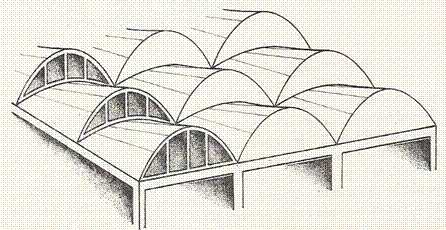Conoid on:
[Wikipedia]
[Google]
[Amazon]
 In
In
 The parametric representation
:
::::
describes a ''parabolic conoid'' with the equation . The conoid has a parabola as directrix, the y-axis as axis and a plane parallel to the x-z-plane as directrix plane. It is used by architects as roof surface (s. below).
The parabolic conoid has no singular points.
The parametric representation
:
::::
describes a ''parabolic conoid'' with the equation . The conoid has a parabola as directrix, the y-axis as axis and a plane parallel to the x-z-plane as directrix plane. It is used by architects as roof surface (s. below).
The parabolic conoid has no singular points.
Hyp-paraboloid.svg, hyperbolic paraboloid
Pluecker-conoid.svg, Plücker conoid
Whitney-umbrella.svg, Whitney umbrella


mathworld: Plücker conoid
*
() * Vladimir Y. Rovenskii, ''Geometry of curves and surfaces with MAPLE'
({{ISBN, 978-0-8176-4074-3) Surfaces Geometric shapes
geometry
Geometry (; ) is, with arithmetic, one of the oldest branches of mathematics. It is concerned with properties of space such as the distance, shape, size, and relative position of figures. A mathematician who works in the field of geometry is c ...
a conoid () is a ruled surface
In geometry, a surface is ruled (also called a scroll) if through every point of there is a straight line that lies on . Examples include the plane, the lateral surface of a cylinder or cone, a conical surface with elliptical directri ...
, whose rulings (lines) fulfill the additional conditions:
:(1) All rulings are parallel to a plane, the '' directrix plane''.
:(2) All rulings intersect a fixed line, the ''axis''.
The conoid is a right conoid
In geometry, a right conoid is a ruled surface generated by a family of straight lines that all intersect perpendicularly to a fixed straight line, called the ''axis'' of the right conoid.
Using a Cartesian coordinate system in three-dimensiona ...
if its axis is perpendicular
In elementary geometry, two geometric objects are perpendicular if they intersect at a right angle (90 degrees or π/2 radians). The condition of perpendicularity may be represented graphically using the ''perpendicular symbol'', ⟂. It can ...
to its directrix plane. Hence all rulings are perpendicular to the axis.
Because of (1) any conoid is a Catalan surface and can be represented parametrically by
:
Any curve with fixed parameter is a ruling, describes the ''directrix'' and the vector
Vector most often refers to:
*Euclidean vector, a quantity with a magnitude and a direction
*Vector (epidemiology), an agent that carries and transmits an infectious pathogen into another living organism
Vector may also refer to:
Mathematic ...
s are all parallel to the directrix plane. The planarity of the vectors can be represented by
:.
If the directrix is a circle, the conoid is called a circular conoid.
The term ''conoid'' was already used by Archimedes
Archimedes of Syracuse (;; ) was a Greek mathematician, physicist, engineer, astronomer, and inventor from the ancient city of Syracuse in Sicily. Although few details of his life are known, he is regarded as one of the leading scienti ...
in his treatise '' On Conoids and Spheroides''.
Examples
Right circular conoid
The parametric representation : :describes a right circular conoid with the unit circle of the x-y-plane as directrix and a directrix plane, which is parallel to the y--z-plane. Its axis is the line ''Special features'': # The intersection with a horizontal plane is an ellipse. # is an implicit representation. Hence the right circular conoid is a surface of degree 4. # Kepler's rule gives for a right circular conoid with radius and height the exact volume: . The implicit representation is fulfilled by the points of the line , too. For these points there exist notangent plane
In geometry, the tangent line (or simply tangent) to a plane curve at a given point is the straight line that "just touches" the curve at that point. Leibniz defined it as the line through a pair of infinitely close points on the curve. More ...
s. Such points are called ''singular''.
Parabolic conoid
Further examples
#hyperbolic paraboloid
In geometry, a paraboloid is a quadric surface that has exactly one axis of symmetry and no center of symmetry. The term "paraboloid" is derived from parabola, which refers to a conic section that has a similar property of symmetry.
Every pla ...
# Plücker conoid
#Whitney Umbrella
frame, Section of the surface
In geometry, the Whitney umbrella (or Whitney's umbrella, named after American mathematician Hassler Whitney, and sometimes called a Cayley umbrella) is a specific self-intersecting ruled surface placed in three dim ...
#helicoid
The helicoid, also known as helical surface, after the plane and the catenoid, is the third minimal surface to be known.
Description
It was described by Euler in 1774 and by Jean Baptiste Meusnier in 1776. Its name derives from its similar ...
Applications


Mathematics
There are a lot of conoids with singular points, which are investigated in algebraic geometry.Architecture
Like other ruled surfaces conoids are of high interest with architects, because they can be built using beams or bars. Right conoids can be manufactured easily: one threads bars onto an axis such that they can be rotated around this axis, only. Afterwards one deflects the bars by a directrix and generates a conoid (s. parabolic conoid).External links
mathworld: Plücker conoid
*
References
* A. Gray, E. Abbena, S. Salamon, ''Modern differential geometry of curves and surfaces with Mathematica'', 3rd ed. Boca Raton, FL:CRC Press, 2006.() * Vladimir Y. Rovenskii, ''Geometry of curves and surfaces with MAPLE'
({{ISBN, 978-0-8176-4074-3) Surfaces Geometric shapes